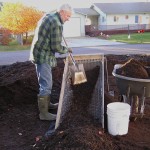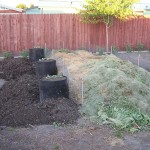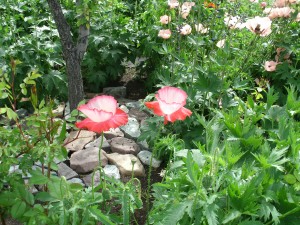by Catherine Haug, with David Brown, July 15, 2011
(all photos by David Brown unless noted otherwise)
Kalispell gardener and composter David Brown has been conducting composting experiments in his yard for years. From using a simple hole in the ground which he fills with kitchen and yard waste, to a sophisticated separating toilet, David is a wealth of ideas.
See also his earlier article, originally published in the Daily InterLake: Composting: Yard Waste (11).
On composting
“This year I’m mostly correcting mistakes of the past, for more compost with less effort:
- I used to run finished compost through a shredder. Now I screen it. (photo, above)
- I used to turn compost with a fork. Now I rototill it.
I’m currently using a long bin (photo, left) to accumulate grass clippings and yard waste. A lawn mower works great to chop up piles of crop residue, leaves, etc. I use a Patriot shredder to chop up tree branches and raspberry canes.
About half a mile from our home sit piles of leaves in various stages of decomposition. Every year the city dumps about 350 truck loads of leaves on property just south of the sewage treatment plant. The leaves are turned once or twice each summer. About three years after the initial deposit they are pretty much dirt. I have the option of either filling my van with fresh leaves or composted material which I sift.”
Stone mulching
He is also experimenting with stone mulching, such as around his pear tree (photo below):
“The stones increase earthworm activity. I feed my fruit trees about 5 inches of leaves a year. It all pretty much disappears from one season to the next. For more on this technique, see Stone Mulching in the Garden: J. I. Rodale: Books.”
See also this interesting blog post on stone mulching in the desert (but has lots of good info for any climate, and could prove useful as our local climate warms): Stone Mulching in the Desert
Composting Human Waste
Now David is working on improving his humanure toilet. Currently it is a box positioned over a hole in his yard, but nothing like your Grandparents’ outhouse:
David’s humanure toilet
“I recently installed a box with a lid in my front yard. Materials cost about 35 dollars. I made mine from scraps of Trex composite decking so all I had to purchase was screws, hinges and and a handle.
The hole (nutrient reservoir) is 14 x 22 inches and three feet deep. That’s almost 6 cubic feet of vermicomposting space. All organic household kitchen waste goes into the hole. When time permits I plan to build a separating toilet to collect urine and poop. Details of that arrangement are still under development but the basic design is firm.
Kitchen waste and poop are not the only materials that go into the hole. In summer I also dump in weeds (especially ones going to seed) and periodically sprinkle a little compost enriched dirt in the hole to bury the more odoriferous waste.
I figure a minimum of 140 gallons of water per person per month is required to send urine and poop to the sewage treatment plant. With three people in our household, a separating toilet would reduce our water usage by about 5,000 gallons per year.
When the nutrient reservoir gets full I cap it with dirt and move the arrangement to another location. My first hole took seven months to fill. I was in a hurry so quite a bit of yard waste went into that hole. This spring I planted sunflowers over that nutrient reservoir to see how big they get compared to nearby sunflowers growing in topsoil of normal depth.” (2)
When I queried about odor, David replied, “On job sites we’ve used my box toilet a number of times inside closed up houses. No odor problem.” (7/13/11 email)
Separating human waste
David describes his own design for a separating toilet:
“Most (if not all) of the odor problem disappears when urine and feces are separated. I haven’t built a separating toilet yet but have the configuration pretty much worked out.
- The forward part will consist of a funnel connected to a piece of tubing with a loop. A little water poured into the funnel after urination clears the urine from the loop which discharges into a two gallon container.
- The back part of the toilet will house a drawer to collect the solid waste. Instead of a toilet tank there will be a box containing dry matter which may consist of finished compost, sawdust, or yard debris like you used. My preference is sifted compost. All that’s needed is a scoop and a hopper arrangement to direct the dry matter onto the solid waste material.
David also sent this interesting article for my post on Recycling Wood or Briquette Ash (10), but pertinent here as well, from The Best Years in Life: Grow Hearty Tomatoes Using your Bladder and Fireplace (9).
Cat’s Indoor Privy
In the 1980s, I spent most of my weekends at a primitive beach cabin on the Oregon coast. It wasn’t right on the coast, but set back at the base of the Coast Range, in a lovely creek meadow. It was built from a deconstructed homestead outside of Salem OR. Very primitive. It had a wood cooking range, and running water from a spring farther up the mountain, delivered to the cabin by gravity feed hose.
Instead of a flush toilet. Instead, it had an indoor privy. This was a ventilated closet in one corner of the cabin. This closet was a lot like an outhouse, except the chamber below was built of cinder blocks, and had a door for outside access (the cabin was built on a slope). We added yard debris (mostly cedar needles) with every personal addition, and also added kitchen waste and ash from the wood range to the chamber. Then once a year we opened the outside door to the chamber, and moved the composted pile to a compost bin near the garden, where it continued to ‘cure’ for another year before being used on the garden.
That Oregon privy never had a bad smell. It just smelled like a coastal forest, I suppose because of all the cedar needles. But I’ve known others who have had a similar privy who complain of stink, so I don’t know what was different about our privy. Perhaps it was the ash from the wood stove…
Terra Preta in Brazil’s Amazon
From David: “Related to [my] experiment in [soil] fertility is a recent Washington Post article about vanished Amazon Rain Forest cultures: Scientists find evidence discrediting theory Amazon was virtually unlivable. From the article (7):
‘Outside Manaus, Brazil, Eduardo Neves, a renowned Brazilian archaeologist, and American scientists have found huge swaths of ‘terra preta,’ so-called Indian dark earth, land made fertile by mixing charcoal, human waste and other organic matter with soil. In 15 years of work they have also found vast orchards of semi-domesticated fruit trees, though they appear like forest untrammeled by man…Three feet deep here, and stretching nearly 100 acres, this terra preta could have fed at least 5,000 people.’
So how about it? There’s lots of dirt that needs enriching and lots of urine poop that needs to be disposed of and lots of people who need to be fed.”
See also Terra Preta Gardens (8) website for lots more!
For more on composting human waste
David directed me to an interesting website from Ecuador: The Black Sheep Inn (3), an eco-friendly resort that, among other amenities, provides humanure toilets in every lodging. Their website has lots of great ideas and photos.
See also the Humanure Handbook by Joseph Jenkins (1), for more ideas.
Composted sewage sludge
There has been discussion in the press recently about commercial compost, such as Glacier Gold, that is made from sewage sludge. For example:
- Planet Natural: Is Your Compost Made of Sewage? The Truth About Biosolids.
- OCA: What San Francisco Found in Their Own Sludge
- OCA: US Chef Alice Waters Criticised over Sewage Fertilizer
- OCA: Rural Pennsylvania Township Wins First Round of Sludge Fight Against Attorney General
David says: “As far as Glacier Gold is concerned, I don’t trust it because of the possibility of containing household chemicals, synthetic drugs, and heavy metals. Perhaps these elements are diluted enough to not be a problem – but still…”
The Humanure Handbook (1) offers some reassurance:
- A compost pile that reaches and sustains thermophilic temperatures (above 111° – 125° F) for a week should break down all (or most) pharmaceuticals and household chemicals.
- Compost temperature of 122° F for 24 hours will kill all known pathogens.
- Several studies have demonstrated that maintaining composting sewage sludge between 116° and 130° F for 3 days will also kill all polio virus, salmonella, roundworm eggs, and candida albicans.
The issue then becomes whether or not Glacier Gold compost has ever reached and sustained those warmer temperatures.
Heavy metals, which cannot be broken down from their elemental form, are definitely a concern. All of us are exposed to mercury if we have mercury fillings, and those of my generation are also likely have toxic levels of lead. Smokers have toxic levels of cadmium. But at least around here, we don’t (yet) have industrial companies polluting our ground water and streams with heavy metals.
Chlorella, a blue-green algae, is used to remove heavy metals from water by chelating them. My hope is that related microbes in compost could do the same in soil, so the metals cannot be taken up by plants, and thus not contaminate our diet.
References, and For More Information:
- Humanure Handbook, by Joseph Jenkins (see Amazon for a peak inside)
- Sciencebase.com: Water Blog Action Day
- The Black Sheep Inn: Conservation at the Inn
- Planet Natural: Is Your Compost Made of Sewage? The Truth About Biosolids.
- OCA: What San Francisco Found in Their Own Sludge;US Chef Alice Waters Criticised over Sewage Fertilizer; and Rural Pennsylvania Township Wins First Round of Sludge Fight Against Attorney General
- Stone Mulching in the Garden: J. I. Rodale: Books (link to Amazon.com)
- Washington Post: Scientists find evidence discrediting theory Amazon was virtually unlivable
- Terra Preta Gardens
- The Best Years in Life: Grow Hearty Tomatoes Using your Bladder and Fireplace
- The EssentiaList: Recycling Wood or Briquette Ash
- The EssentiaList: Composting: Yard Waste (by David Brown)
- The EssentiaList: Turning Human Waste into Compost: Humanure
- The EssentiaList: What Makes Your Compost Tick?



chippers reviews…
[…]On Composting, Mulching, Humanure, & Sewage Sludge « The EssentiaList[…]…